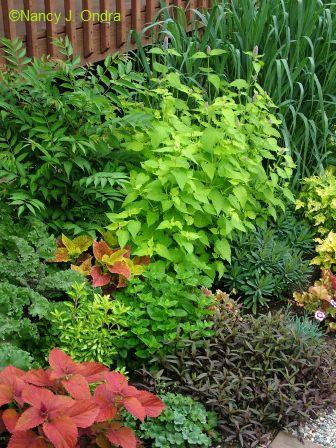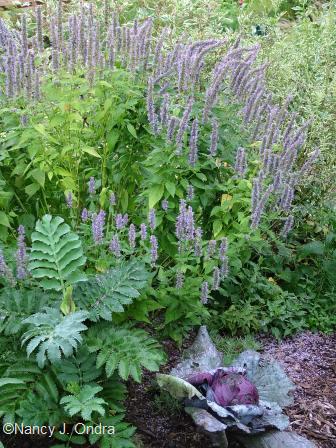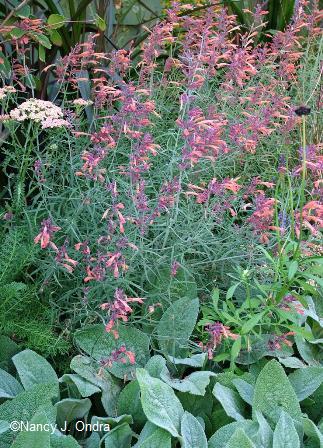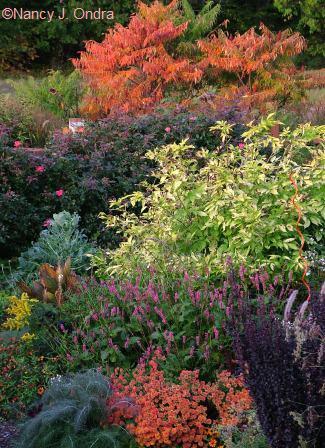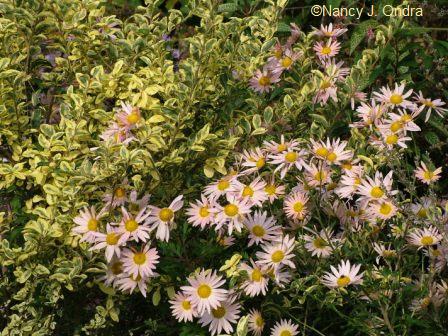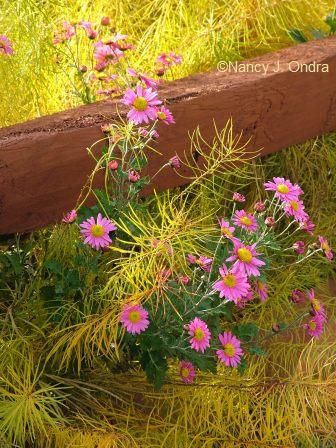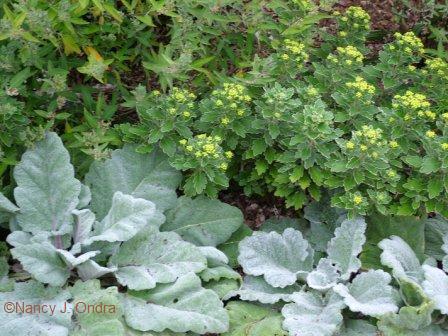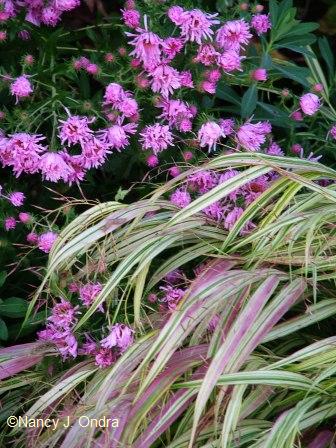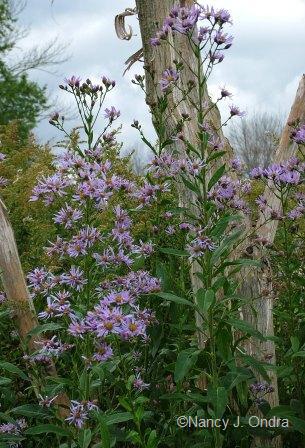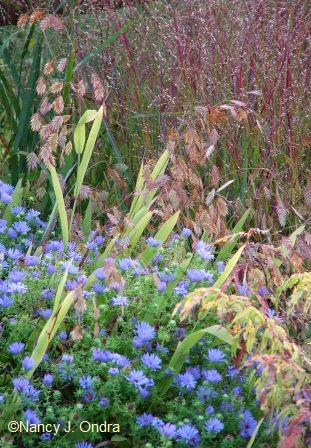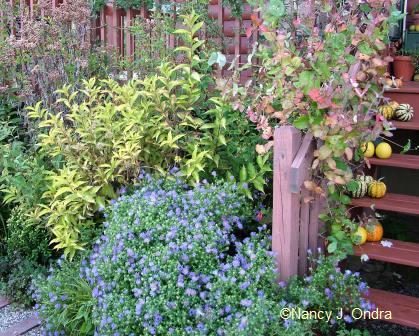All of you who apologize for getting in your Design Workshop contributions right at the end of the month can feel a little smug now, because here I’m doing the same thing to Fran. Sorry Fran!
First, a few comments on her GGW Plant Pick of the Month for September: Agastache. Anise hyssop (Agastache foeniculum) was one of the first perennials I grew successfully from seed, and I was very fond of it for a few years, grateful for its speedy growth, its abundant flowers, and its root beer-scented foliage. It taught me an important lesson in perennial propagation, however: If a plant is easy for even a novice gardener to grow from seed, there’s a good probability that it will just as easily grow itself from seed. Enthusiastically. Everywhere.
After pulling out a super-abundance of excess seedlings for several years in a row, I finally managed to get rid of it. I’m not saying it’s a bad plant – far from it – but you really need to keep the seeding issue in mind, and keep the faded flower spikes clipped off to minimize the self-sowing potential.
One thing that lured me back into the world of agastaches was the release of the cultivar ‘Golden Jubilee’. As you can see in the photo at the top of this post, this beauty has clear yellow to red-tinged yellow new foliage. Granted, it too seeds freely, but I can forgive it for that more readily than I can the ordinary green-leaved forms. It does turn kind of a sickly yellow-green in summer heat, so shearing it a few times in summer serves a double purpose: It encourages bright new shoots to form (as in the July shot below), and it keeps the self-sowing to manageable levels.
When the hybrid ‘Blue Fortune’ (a cross between A. foeniculum and A. rugosum) was released a while back, I decided to try it too, because the word was that it did not produce viable seeds: hence, no seedlings! It certainly bloomed its heart out from midsummer well into fall with no deadheading, and no seedlings the next year.
It came back the next year and bloomed pretty well then too, though the clump wasn’t quite as dense.
And by the following spring, it was gone. I suspect it just wore itself out, as some heavy-blooming, later-flowering perennials are prone to do. Now, what puzzles me is that I’ve been seeing what’s touted as ‘Blue Fortune’ appearing in seed exchange lists and even a few seed catalogs. So, what’s the deal? As far as I understand, the true ‘Blue Fortune’ is propagated only by cuttings or division. But somewhere along the line, I guess someone got a mislabeled plant that did set seed? If anyone knows the real scoop on this, please share!
Over the years, I’ve dabbled in some of the western agastaches, mostly A. rupestris (love that pinkish peach color)…
…and this year, a couple of A. cana strains, and A. mearnsii (not ooh-ah, just ordinarily pretty with pink spikes on plants about 2 feet tall). None of these overwinter in my winter-wet southeastern PA garden, so they serve as annuals for me. And I’m all for annuals that get better-looking as the season goes on, so I imagine I’ll always sow a few of these each spring to enjoy their color and form from late summer through frost.
And now, on to the issue of chrysanthemums versus asters. I admit to having a few mums I’m fond of, particularly a pumpkin-orange hybrid whose label disappeared years ago. In the image below, it’s just coming into bloom in September of last year…
…and here it is yesterday, on its way out but doing a nice job echoing the fall color of a cutleaf sumac (Rhus typhina ‘Laciniata’).
In another week or two, ‘Sheffield Pink’ should finally open (the shot below is from mid-October of 2006, with Ligustrum ‘Swift Creek’). I wish the color were a bit richer, but the plant form is such a perfect mound even without pinching that I think I’d grow it even if it never flowered.
Toward the end of October, a few self-sown mum seedlings appear here and there.
And a bit after that, ‘Mei-Kyo’ bursts into bloom (the image below is from October 29 of last year, with the hips of Rosa rubiginosa):
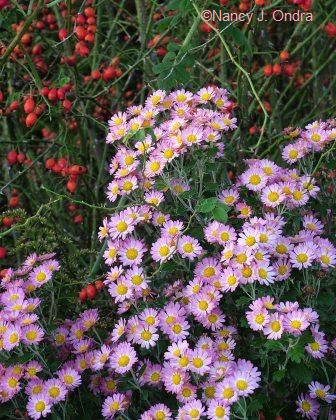
I still think of gold-and-silver chrysanthemum as Chrysanthemum pacificum, though now it is technically Ajania pacifica. This has such handsome foliage that it really doesn’t need to flower…
…but if we don’t get a freeze while the buds are forming, it can look okay in bloom too.
If I absolutely had to choose between mums and asters, though, I’m pretty sure that I’d have to go with asters. I very much like some of the pink Aster novae-angliae clumps that have seeded around from the original ‘Harrington’s Pink’ I planted years ago. Here, one echoes the fall color of golden Hakone grass (Hakonechloa macra ‘Aureola’):
Here, another sets off the intensity of ‘Hopi Red Dye’ amaranth (Amaranthus):
And here, yet another mingles with a tiny-flowered white aster that seeded in from the nearby meadow:
I also adore – as I’ve read that many of you do too – the tall-stemmed, late-blooming flowers of Tatarian aster (A. tataricus, shown here in mid-November of 2006 against the stems of Heptacodium miconioides):
‘Bluebird’ smooth aster (A. laevis) is much shorter and blooms about two months earlier (around early September here), but it’s cute too, and it seems to tolerate a fair bit of shade.
But my very favorite, wouldn’t-ever-be-without aster is an easy pick: Aster oblongifolius. I originally bought both ‘Raydon’s Favorite’ and ‘October Skies’, but they’ve crossed and seeded around over the years, and the seedlings all pretty much look alike to me. The only problem I have is that either mice or voles are very fond of eating the roots and crowns during the winter. But even if the original plants don’t make it, there are always volunteers coming along, naturally forming tight, topiary-like, 2- to 3-foot-tall and-wide mounds that are covered with buds by late summer and smothered in purple-blue blooms from early September well into October. Such a pretty thing, wherever it is! Below, it’s mingling with the seedheads of Chasmanthium latifolium and the red fall foliage of ‘Shenandoah’ switch grass (Panicum virgatum)…
…and here, it’s anchoring the corner of a foundation planting, with yellow-leaved Briant Rubidor weigela and ‘Dropmore Scarlet’ honeysuckle (Lonicera) in orangey fall color:
Now, a parting thought for any of you who have actually read this far: Perhaps It really doesn’t matter whether you prefer mums or asters, as long as you use them effectively, whether your goal is to create a quiet harmony or a traffic-stopping spectacle?
(If you really want to know more about this mountain-o-mums, you can read all about it in More Mum Madness.)


